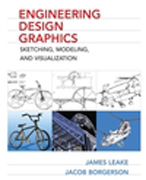
Following a unique approach, this book utilizes freehand sketching techniquesto present the fundamentals of engineering graphics as well as to develop visualization skills. Readers will be guided through critical concepts ranging from projection theory and pictorial sketching to parametric solid modeling and product dissection. They'll find planar projection theory serves as the basis for discussion of the various types of freehand sketching techniques. INDICE: Chapter 1 Engineering Design. Introduction. Aspects of engineeringdesign. Analysis and design. Product anatomy. Design phases. Design process overview. Needs assessment. Problem definition. Background research. Design criteria. Design constraints. Alternative solutions. Analysis. Evaluation and selection. Specification. Communication. Written reports. Recommended report writing steps. Oral presentations. Concurrent engineering. Design for manufacture and assembly. Teamwork. Chapter 2 Sketching and Other Concepts. Introduction. Sketching tools and materials. Sketching techniques. Line techniques. Sketching straight lines. Sketching circles. Sketching ellipses. Proportioning. Estimating dimensions of actual objects. Partitioning lines. Instrument usage - Triangles. Parallel lines. Perpendicular lines. Instrument usage - Scales. Introduction. Engineers scale. Engineers scale example. Architects scale. Architects scale example. Mechanical scale. Mechanical scale example. Metric scale. Metric scale example 1. Metric scale example 2. Line styles. Chapter 3 Planar Projections Multiviews. Multiview Sketching. Introduction justification and some characteristics. Glass box theory. Alignment of views. Transfer of depth. View selection. Third and first-angle projection. Line conventions. Multiview drawing of a cylinder. Line precedence. Generic three multiview sketch procedure. Step-by-step multiview sketch example. Intersections and tangency. Fillets and rounds. Machined holes. Conventional representations: rotated features. Step-by-step multiview sketch example: object with complex features. Visualization Techniques for Multiview Drawings. Introduction and motivation. Treatment of common surfaces. Normal surfaces. Inclined surfaces. Oblique surfaces. Projectionstudies. Adjacent areas. Surface labeling. Similar shapes. Vertex labeling. Analysis by feature. Missing line and missing view problems. Chapter 5 Auxiliary and Section Views. Auxiliary Views. Introduction. Definitions. Auxiliary view projection theory. Auxiliary views: Three cases. General sketching procedurefor finding a primary auxiliary view. Finding a primary auxiliary view of an contoured surface. Sectional Views. Introduction. Sectional view process. Section lining (hatch patterns). Full sections. Half sections. Offset sections. Broken out sections. Revolved sections. Removed sections. Conventional representations: sectional views. Conventional representations: thin features. Section view construction process. Conventional representations: aligned sections. Assembly sectional views. Chapter 6 Dimensioning and Tolerancing. Dimensioning. Introduction. Units of measurement. Application of dimensions. Terminology. Reading direction for dimensional values. Arrangement, placement and spacing of dimensions. Using dimensions to specify size and locate features. Symbols, abbreviations, and general notes. Dimensioning rules and guidelines. Prisms. Cylinders and arcs. Tolerancing. Introduction. Definitions. Tolerance declaration. Tolerance accumulation. Mated parts. Basic hole system: English units. Stepbystep tolerance calculation of a clearance fit using the basic hole system. Stepbystep tolerance calculation of an interference fit using the basic hole system. Basic shaft system: English units..etc.
- ISBN: 978-0-471-76268-3
- Editorial: John Wiley & Sons
- Encuadernacion: Rústica
- Páginas: 332
- Fecha Publicación: 01/05/2008
- Nº Volúmenes: 1
- Idioma: Inglés
